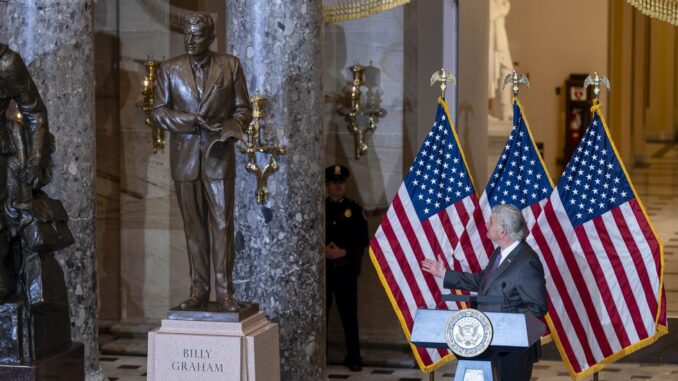
Billy Graham was known the world over — not bad for a Southern Baptist preacher from North Carolina.
Many of us feel some connection with the famed evangelist either directly or indirectly. For most, it was the televised crusades through the years. The Graham organization discovered early on the value of television in reaching millions with the gospel message. The crusade choirs, the singing of George Beverly Shea and the preaching still resonate.
I remember well the first Graham crusade I personally attended in 1973 at Carter Stadium in Raleigh. I was in law school in Chapel Hill, and Margaret and I were living in Cary. We attended every night of the crusade in the packed stadium and have never forgotten singing the great hymns of the faith with a host of fellow believers and then hearing Dr. Graham preach the Word in his distinctive homiletic style.
I later met Billy Graham personally when he preached at my church. I consider his daughter, Anne Lotz, a friend, and her late husband, Dan, was my dentist until he retired. The Lotz family are special folks and are such a blessing to Raleigh’s Christian community.
Public interest in the ministry of Billy Graham was rekindled last week with the historic unveiling of his 7-foot-tall bronze statue in the United States Capitol. The event was nationally televised and viewed by millions. Speaker Mike Johnson of Louisiana, himself a distinguished Baptist layman, hosted the ceremony and emotionally recalled Graham’s 1951 Shreveport crusade:
“And over the course of three weeks, he preached to approximately 200,000 people, which is greater than the population of the whole northwest corner of the state, so they came in from all over the place. And one of the men who was present at those meetings seven decades ago led my own father to Christ. And other people who were present at those meetings were my childhood pastors and my Sunday school teachers, who all had a massive influence, of course, upon me.
“And the gospel they heard of Jesus Christ’s death and resurrection is the gospel that they preached to me and my siblings, and everybody in my sphere of influence. And that’s the message that’s changed my life for eternity, and which Rev. Graham knew would change every person’s life.”
So it’s true, just about every one of us has a Billy Graham story to tell — even the Speaker.
One does not land in Statuary Hall by chance, even for a man of such prominence as Graham; the process was initiated by the North Carolina General Assembly in 2015. Upon Graham’s death in 2018 at age 99, work began in earnest on the project. Three friends of mine — Paul Coble, Garrett Dimond and Susan Whitehead — staffed the effort and spent the past six years tirelessly working to make the unveiling ceremony last week a reality. They deserve our heartfelt thanks.
So now Christianity’s most prolific and beloved evangelist once known as “America’s Pastor” has been immortalized in the halls of Congress on behalf of his native North Carolina. Kind of makes me proud to be a Tar Heel.
As Franklin Graham said, “Father would have been a little uncomfortable with the statue because he would want the focus to be on the One that he preached about — the Lord Jesus Christ, the Son of God.”
No doubt the focus was on Christ and, at a time when our nation needs the gospel more than ever, I am grateful we paused for a moment to honor the remarkable legacy of Billy Graham in such a memorable way.
Sam Currin is a former judge, law professor and U.S. attorney. He lives in Raleigh.
